INTRODUCTION
This project was done alongside the course material and became a journey into the Fungal Kingdom. From the onset of this project, I was guided by my tutor to consider collaborative agency and read Vibrant Matter by Janet Bennet to assist in my contextual thinking and making process. Making was seen as a reflection of learning, which started very much around the choice of materials. The use of Japanese Rice Paper and opportunities to document my own exploration of materiality soon followed. I found it exciting how my choice of fragile paper, like Velour and thin printing paper as support materials, continued to be explored in this project. As the project developed I found that the physical connection with fungi and being able to make spore prints became a way to understand a collaborative agency with materials and objects. I was challenged by an idea of a bit of alchemy that was at play in the possible making and connection with the natural world. My making was mostly investigative and I was encouraged in tutorials to embrace ideas which was developing, which also was necessary to gain focus through the process. I was encouraged to reflect on my intentions as ideas developed in order for the work to stay evocative. By starting to grow my own mushrooms later in the project, the material became something to interact with and learn from.
Tsing uses the notion of ‘assemblage’ or ‘species assemblage’ as never settled, they are open-ended gatherings (2015: 22-23). I think it is fair to say that collaboration as I began this project, is understood as both a means and a goal. I chose to focus on the open-endedness of this creative ‘authorship thing’, which happened, and as this project developed, the more I found the mushroom as the ‘collaborator’. The main focus of my project set out to use practice-led research in my making. I look at this parallel project as a research project and continue to link the making to my current Studio Practice studies. I also respond to work done during my course and link it to how I experience the Fungal Kingdom, the body of work will deal with processes, materials, and techniques. I came to understand my Parallel Project as a journey and an inquiry into the landscape around me, as well as about connecting human and non-human interactions. I would like to think of the body of work being made in this project as a story of observing and trying to show an experience of being in the spaces we share as human and non-human. I am not trying to ignore the fact that we live on a damaged planet, and that there are many concerns and uncertainties, but being more attentive became important to me. I am very aware of the place I live, a farm and very much disturbed due to modern farming practices. I also experienced that, whilst being very aware of environmental crises around me, and concerns about how we continue with life, I felt more optimistic learning about new possibilities when we connect with the other, non-human, around us, and not just see it as commodification and or thing to be used. I believe one cannot look at nature as if it will always be there to provide abundantly and infinitely.
I am influenced by my reading of Jane Bennet, especially looking at assemblages and relations between human and nonhuman actants. By observing the objects I make as part of my everyday lived reality, as an expression of things, living or not living, the making gave me an open-ended way of using my course and learning by applying it to my practice.
I want to acknowledge the role of collaboration in this project, as I also worked alongside a collaborative partner, Annette Holtkamp, who is a fellow student on the Textile pathway as well part of a bigger student group with the focus on developing collaborative work and an online exhibition on 30 June 2022. (OCA EU student group) This online exhibition is on an external platform and will run for 3 months after the opening. I think it is important to mention that I gained a lot from the knowledge that was gathered through this group which pertains to making work, planning for an exhibition, creating own artist statement and writing around the work, as well as other skills that I think are useful to my practice, such as working with other artists around planning the event, marketing and communication. The collaborative project, called the Wander Wide Web, reached the final date as envisioned and after the work was curated by group members who took on the role of curators, it culminated in an online exhibition, which can be viewed through a website as well as an online platform. The link to this exhibition is: https://spaces.oca.ac.uk/wanderwideweb/ Communication between members (students) was online through a closed Facebook group, fortnightly meetings on Zoom, tutorial sessions with OCA tutors and Instagram and WhatsUp groups. The plan is also to have a feedback session with tutor Diana Ali around lessons learned during October 2022.
Later in the project, I observe my own mushrooms growing, do foraging and attempt to bring that learning into my practice by developing new works with mushroom spores as well as re-working or further developing works I started during the project. It is clear to me that this process of working with fungi will not end with this project. I have made connections with like-minded artists who see the benefit of collaborations and connections between humans and non-humans. I reached a space where I think the possibilities opened up ideas of experimental art, leading me to consider bio-art and or installation work. Here artists like Sonja Baumel and Daro Montag who explore ‘the living’ and inherent creativity of the organic world, come to mind.
I also want to consider the Learning Outcomes and Assessment Criteria for Stage Two ( HE5) and how I should be able to comment at the end of this project on these.
In order to consider the reader/viewer, I decided to divide the project into parts and will add my citations, bibliography and list of illustrations, as used for the recommended Harvard Referencing guide, at the end of each Part. When I started that project it was one continuous piece of writing which I later separated as the blogpost became too big.
DEVELOPING A CONCEPT OF FUNGI
This part is about gathering subject knowledge and thinking through how to do the research on the topic, artmaking and artists from which I learn and communicated in this project, through making and documenting. I made a decision to write the work as one continuous work of research, (ideas) and making (outcome). I trust the openness of such a project to stimulate creativity and making. Most of my making starts as exploratory or random, but there is pressure to develop a body of work and learn from the making, alongside doing Studio Practice as current course work. I am also working towards the idea of having work ready for a student exhibition planned for later in 2022. When the Parallel Project( PP) started I was between Part 2 and Part 3 in the course material and looking at making and working on the constituent parts of a painting as well as exploring their potential to act and perform independently of each other. I knew that soon I would also consider the parts of a painting and work with words. Looking at gestural mark-making in the course, and the form of fungi, I consider what making can happen. I can repurpose or redevelop earlier work within the course material as part of the body of work.
My first making was a little clay mushroom I sculptured after discovering mushrooms outside my studio in my veggie patch: small sketchbook drawings followed and knowledge about a mushroom as the fruiting body and part of the Fungal Kingdom, became more than just knowing that mushrooms can erupt overnight. Fungi are everywhere, but as Sheldrake writes, they are easy to miss, as they live their lives largely hidden from our view. The idea that they are inside and around me became fascinating. I learn that microscopic yeasts are fungi, and most plants depend on mycorrhizal fungi. In my home we have been cultivating a bread starter dough for many years, it even travelled to Dubai and back to South Africa. I have experienced how it reacts to different environments, by the taste/flavour of the bread – now I see in mushrooms the same adaptability to the environment and realize the learning hidden here for me.
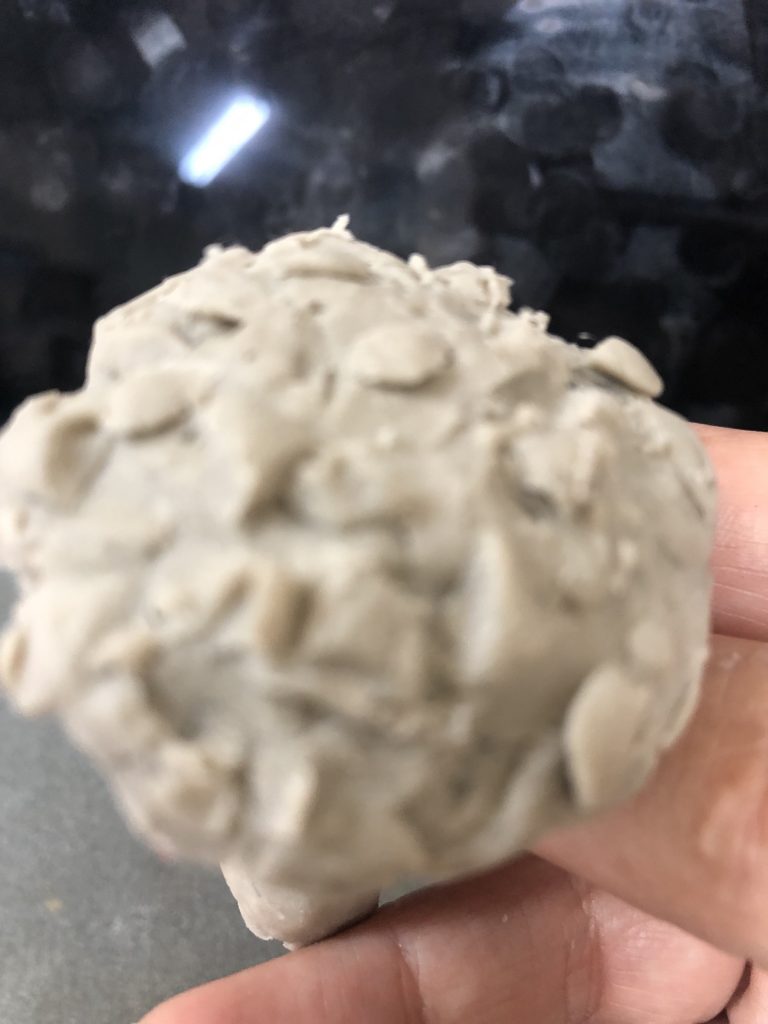
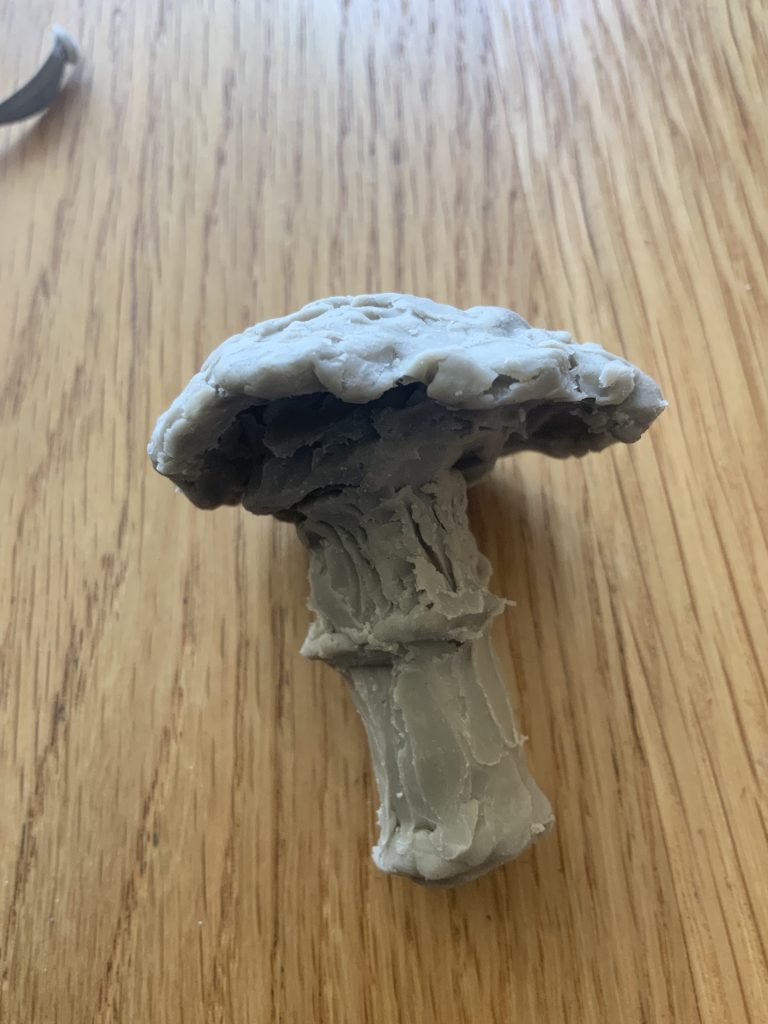
The drawings below were influenced by drawings I saw by Cy Twombly – I considered making a small series and was responding to Annette Holtkamps’ 3d objects. In a way, it was pushing to get acquainted with mushrooms and lichen. It became clear to me that the form of the mushroom in Fig. 4 pulled me in. I value learning from Twombly about how reading and writing are ways to inform your making. Could it also become understanding? I have learned similar ideas from William Kentridge, and realize my drawing need at this stage could be the way I explore and understand a topic or idea – a way, my way, of finding myself.
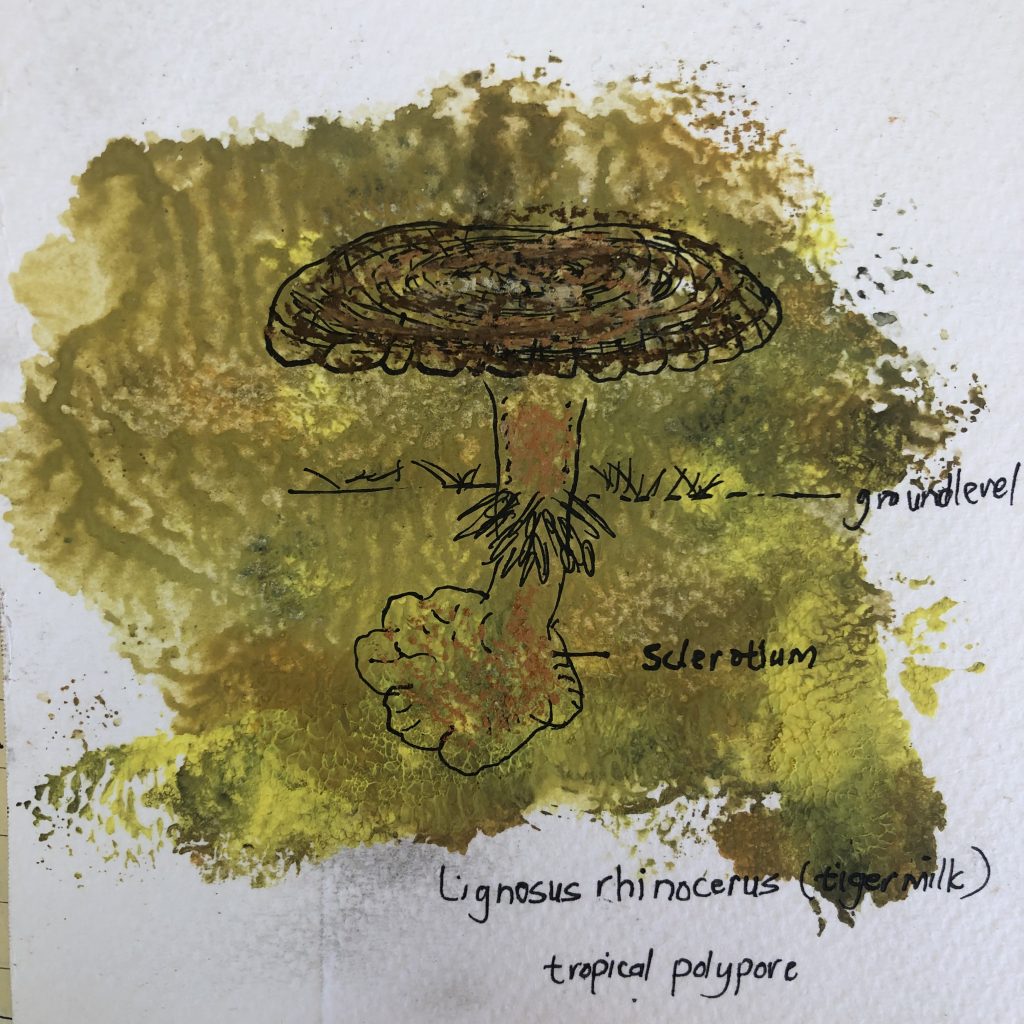
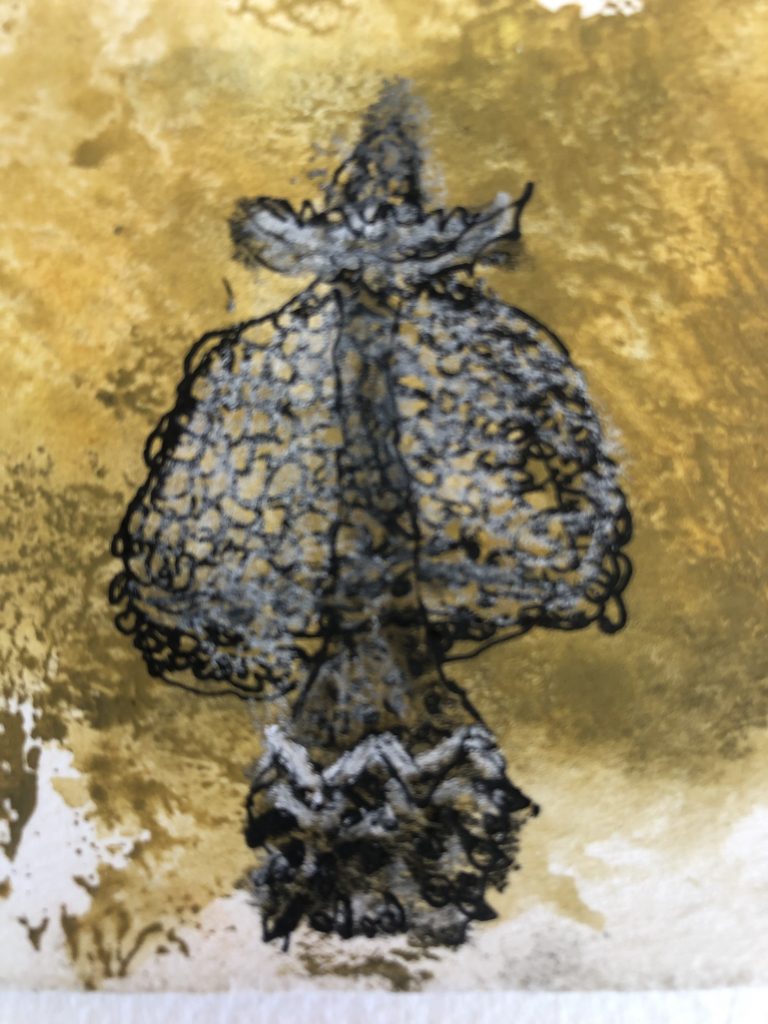
The first painting in the PP was influenced by looking at what it is like to be a fungus – this is inspired by the introduction by Merlin Sheldrake in Entangled Life (2020:3), as well as my research into the work of Cy Twombly, whose colours and gestural marks have now influenced me. For this work on paper,(Fig. 7), I used acrylic paint, acrylic ink, and medium. I painted from the tube to create overlaying network-type lines. The wet effect is almost indicative of a living thing – still moving and connecting as I use gravity to continue adding paint and colour onto the paper surface. I believe I am seeing a way into the work as understanding an alliance between me (us) and the fungi which are being described as perhaps the “most mysterious kingdom of multicellular life”. (New York Times, Joanna Klein, 2019, When Fungi Fight Back) I feel I have the opportunity to look at something which is alive and not static. In my tutoring sessions, I was continuously supported by my tutor to find a way into the ‘lifeforce’ of the fungi – thinking about its structure as cellular layers. It became clear that there was much materiality to be explored.


Close up look
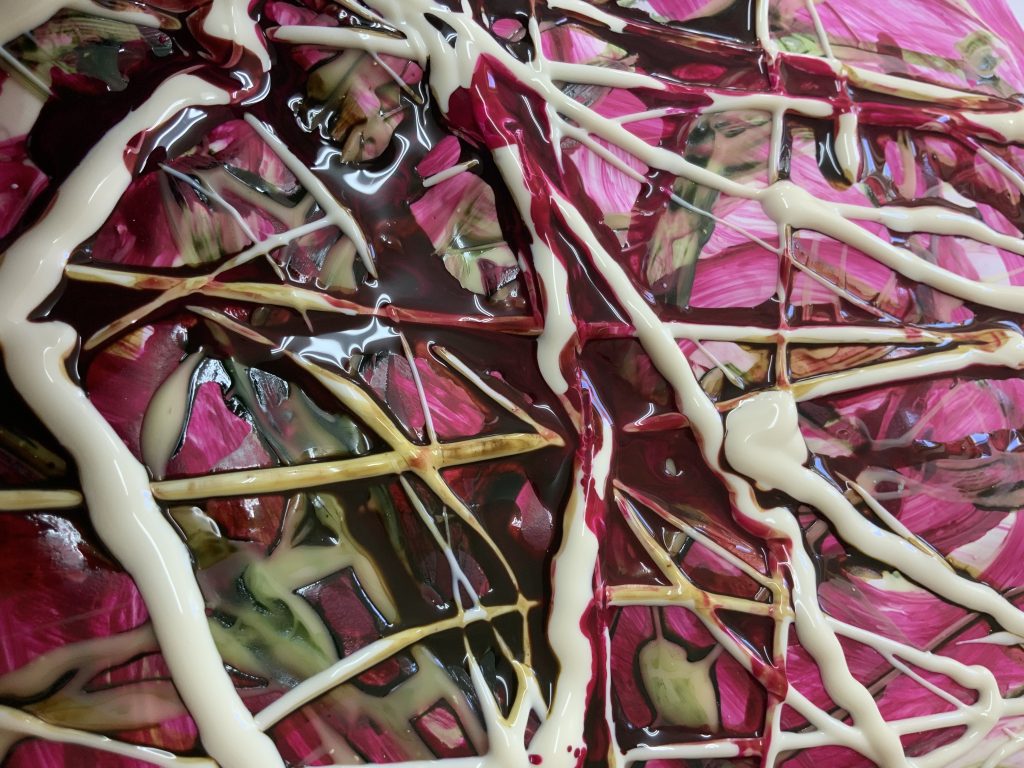
It is important to note that this work was temporary as I used the wet work to create a new work. I would like to think that this was my way into the networks of cells, called hyphae that entangle into the mycelium. I could again look at this making as how I came to understand more about Fungi, as well as being drawn into making more work which would become more abstracted and or seen as re-interpretations.
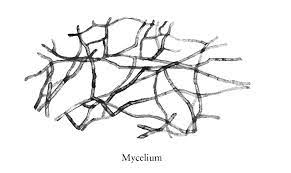
Later when I start foraging and bringing mushrooms into my studio for spore printmaking and learning, I discovered that fungi can ‘collapse’ over a short time. This Shaggy parasol, below, was found under a ficus near our home, (farmyard)see fig. 9. Over the next few days I had two spore prints, fig, 10 and 11. Four days later I found this disintegrated form on the paper where I was attempting to get a third spore print. On closer inspection, I found living white worms on the material which leaves me wondering about insect-fungus collaborations and the decomposing process. Looking more closely at the Shaggy Parasol I learn that is in normally found under trees, in disturbed places, on lawns, gardens and compost piles. It is saprobic.


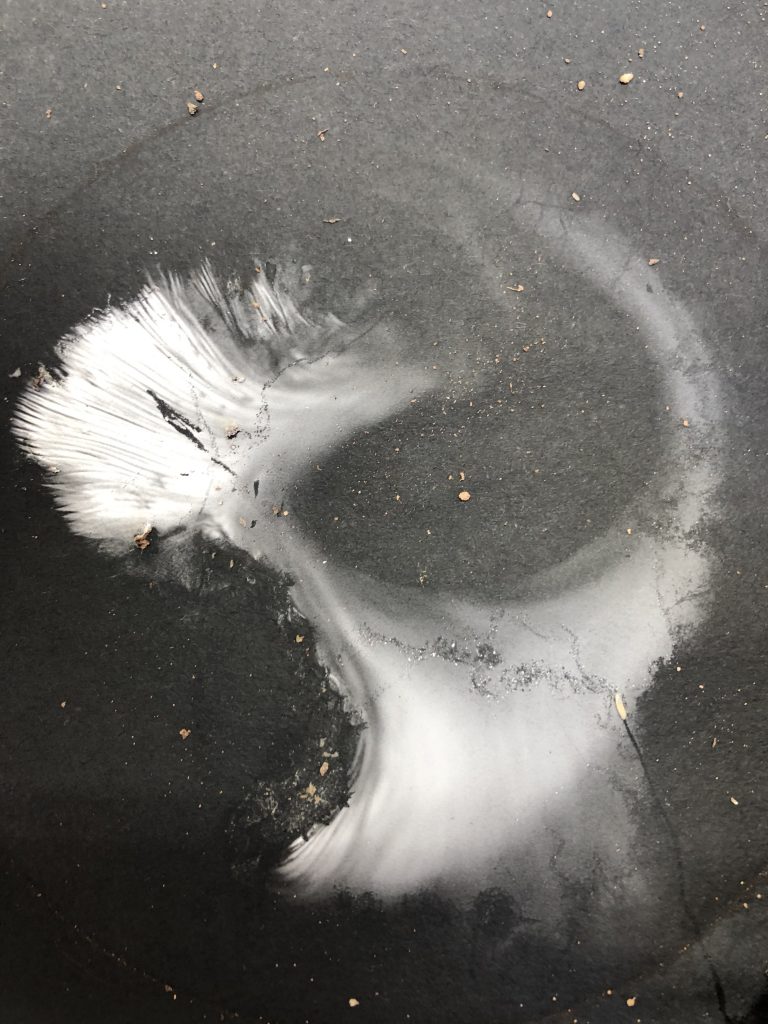
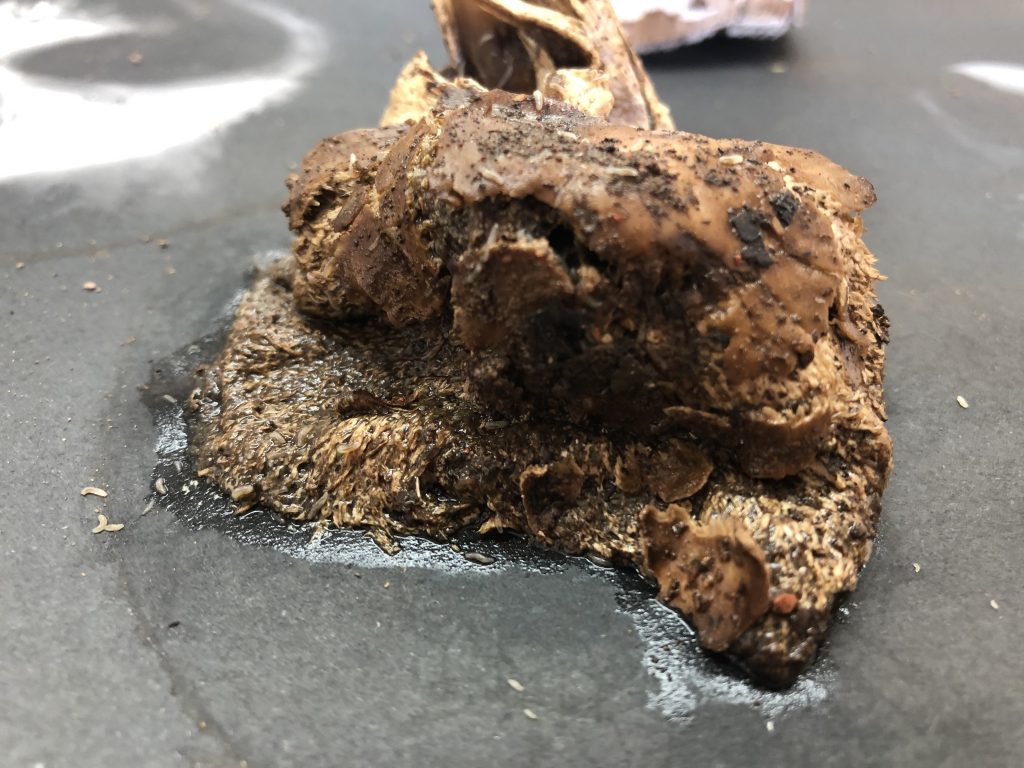

We have a bread yeast, and I can relate to how these cells multiply when we feed (we call her Maja) her flour before we bake. She is kept in the refrigerator to stay dormant when we are not baking. From Merlin Sheldrake (2020) I learn about altering behaviour within mycorrhizal relationships and how I think about these relationships in terms of where it stops – what if all share in the same fungal network, entangled in this net-like fabric? The other observations are also how we as communities function when we consider symbiosis and interdependence. Tim Imgold (2017) has imagined it as knots in a meshwork of lifelines, always something which is becoming, or static. As I made work and had discussions with my tutor, valuable learning was to focus on finding relations with elements in the body of work which was starting to develop, which I could see/use as an assemblage or network as it grew from my research into the Fungal Kingdom, as well as the learning in the course material. In my conversations with Annette ( OCA Eu student) I discovered that Fungi interested her in the time of lockdowns during Covid pandemic and gave her an opportunity to learn more. I like that this is now connecting us.
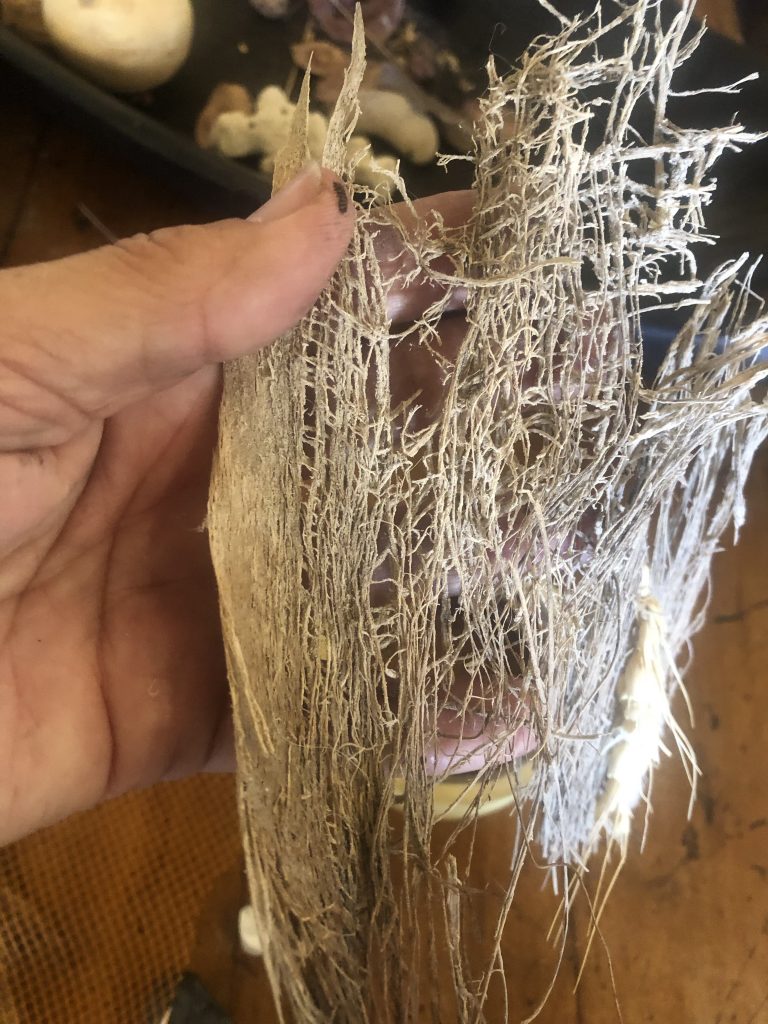
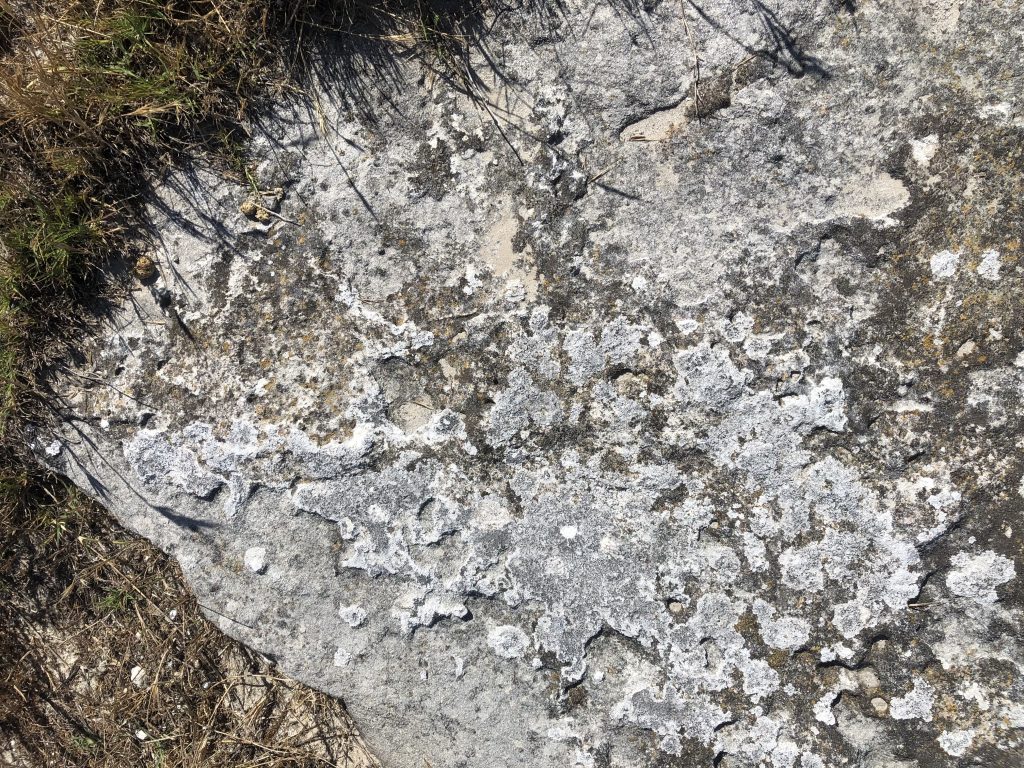
My focus became to consider concepts, materials, and processes I (can) use in my making, as well as ideas I learn from other artists, as well as my tutor. I focussed to be open to reading, discussions, listening and research about the Fungal Kingdom. I wanted to maintain my sense of wonder and feel convinced that making art is a road to knowledge not only about myself but of the world around me. I believe in the interconnectedness between nature and humans and really wonder about the boundaries between us. I find myself inclined to feel that I can do something to respect the Fungi Kingdom, in the way I feel about rhinoceros conservation and the fight against the rhino horn trade that leads to the brutal killing of these animals. I have to acknowledge that I raised a lot of unanswered questions and possibilities. I do need to admit that as an artist I become engaged with issues about nature/land, and reading Liz Wells I understood there will be representation as well as an idealisation in my making and thinking. In her book, Land Matters: Landscape Photography, Culture and Identity, Liz Wells (2002) is concerned with our response to our environment, she describes it as a ‘complex tapestry’ which is made up of real, perceptions of reality, the imaginary, the symbolic, memory and experience. I am more aware that I am using a form of visual interpretation when I start reading Anna Tsing during this project. Over the course of the last few months of June and July 2022, I went back to chapter 1, Landscape: Time, Space, Place, Aesthetics to have serious thinking about how I interact with place and landscape. (p 19 – 58)
I became aware of what is considered natural and artificial when we look at and experience the nature of the landscape. In a way, I have become entangled in alliances that come with history, science, ecology, and/or mycology. I could understand a history of mycology which could be linked with Hippocrates – 460BC, his writings refer to using mushrooms in his practice of medicine. (Field Guide to the Mushrooms of South Africa:8-14) Today we recognise the importance of fungi as food, as fermentation agents, in medicine, as well as ecology, agriculture and industry. I learned that in many African countries mushrooms are an important dietary supplement during the rainy seasons. Edible mushrooms are boiled or pounded after mixing, or dried in the sun or over a fire, and stored for later use. The best know fungi in Southern Africa are ones associated with termites’ nests and these fungi are roasted over coals and eaten raw – then we have truffles that compare with truffles of Europe and are called Kalahari Truffles.
An artist friend recently (17 May 2022) posted her experience of a truffle hunt in the Kalahari. She was born and raised in this area and basically relived a childhood memory of searching for these culinary delicacies, and doing it with an indigenous person, who carries a cultural history of.
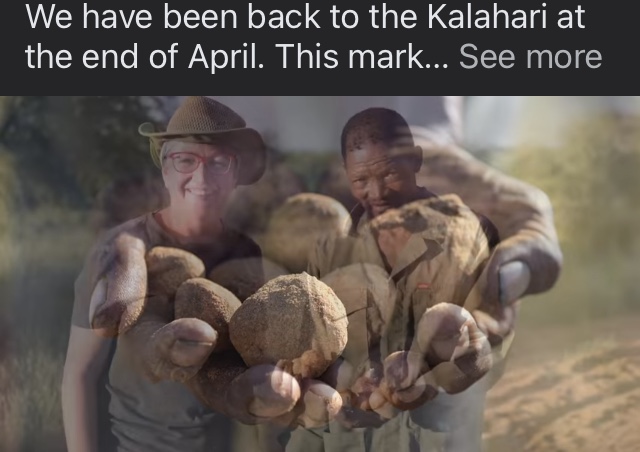
These round forms of the truffles stayed with me when I started making work around Fungi. I had to educate myself about the Fungi Kingdom by reading and watching videos as well as looking at images of fungi, and exploring growing fungi myself. I collected information by making notes, archiving photo images and research material on fungi, interacting with social media groups, listening to videos, and sharing information with collaboration partners within the OCE EU group. I do not live in an area where mushroom collecting is possible during the warmer season. I will only be able to visit such an area in winter, which is not before early June 2022, when our rainy and colder winter season normally starts. I was closer to observing lichen and subsequently brought that as a material and subject into my making.
Looking at my learning within Studio Practice; I have explored the processes behind making a painting and looked at gestures; have worked with materials; considered props and narratives; explored reflective surfaces as a stage on which to perform and then moved on to the parts of a painting by exploring form, deconstructing the canvas and unconventional painting materials, as well as exploring colour charts. The last part of the making looked at text and using words. In a way, these experiences opened ideas for making 3d objects with different materials as well as doing painting and drawing. As I looked more intensely at materiality and how in my making I am drawing from other materials in terms of their diversity and vibrancy, I battled with literalness in my making. My tutor made me aware of how I can take my making to be more explorative and less over-explaining. I realise this is a conscious decision I need to make whilst working with my natural intent to explore and clarify during my making process. Here I considered the link to artist Ian KIaer and how seemingly separate things do or can have a conversation, in my making, especially where in this project I work with a natural form. I discovered that I like to work with fragments of information and need to let these open-ended ways of how I look, come through in my practice.
In the image below (Fig. 17) I used the decalcomania technique and made use of the work shown in Fig. 7 in the wet stage of the making. I later painted and wrote text onto this work to represent mycelium moving. My tutor pointed to the relationship between the notations in the work and the drawn marks as well as the painting. This is an aesthetic I can develop into more works, and influenced by Cy Twombly. I can look at H Bosch’s Garden of Earthly Delight – the painterly parts reminded my tutor of it. It also became a place where I need to work through the literal and not leave the work as one finished piece – I should continue the making and explore. Later when looking at Part 5 there is a reflective exercise in Project 2, which I can use to unpack and discuss these possibilities.
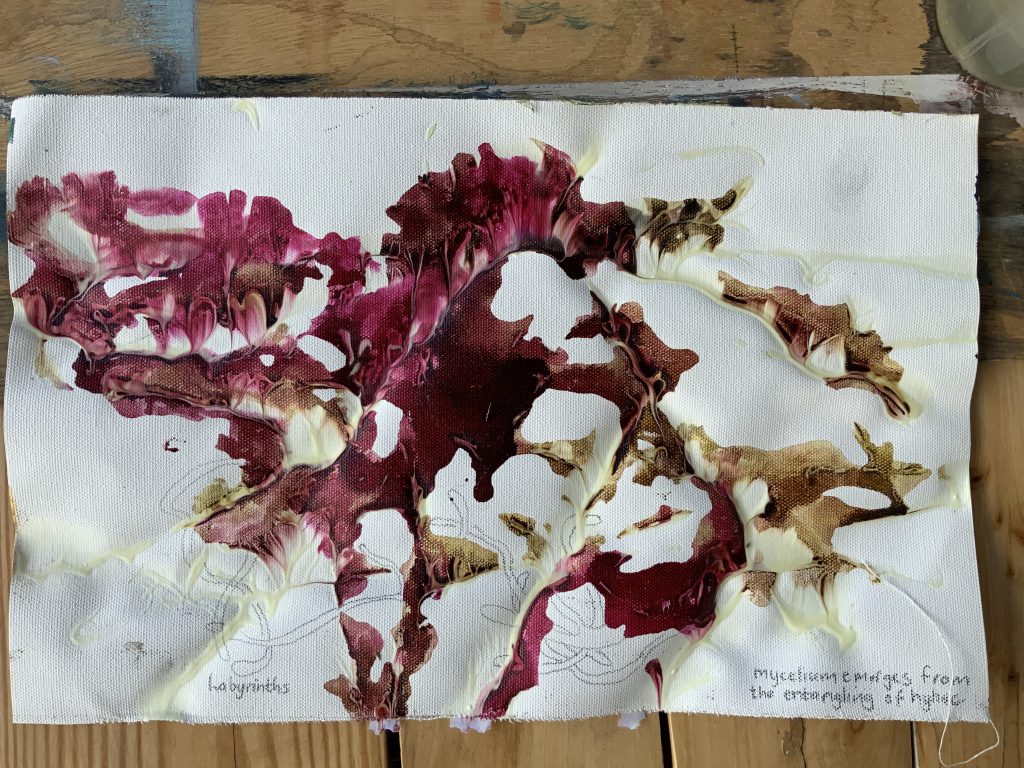
It became clear in my making that in the early exercises I have the opportunity to work by throwing or pouring paint and this could lead to creating lines of form and entanglements. I experiment with other fluid materials such as inks, pouring liquids and acrylic paint, alongside the course material. More works developed where I worked with other materials, such as starter dough (our own Maja bread yeast) and mixing it with paint and varnish and then pouring it onto the canvas paper and finding movement in the work. Both works were done on canvas paper, which allowed for movement as the wet medium reacted with the support – I like the undulations like a landscape created. By now I am more aware of the landscape of the Fungi Kingdom, which is mostly hidden and underground, but also dynamic. In my own mind, I think of mycelium as the roots of a plant, in the case of the mushroom, a fungi root system that is capable of branching out and being an assemblage that regulates so many vibrant things that really wonderful and wonderous. It does take me to materiality and how I try to tune into or listen to what material has to say when making. I feel the dough in the work talks about the food side of mushrooms that can nourish, but also question how and what we eat, as well as where and how food is sourced. Annette Holtkamp my collaborative partner in the work for the EU Student group exhibition, made some of her 3d mushrooms with dough. (see fig. lower down in this blog post)
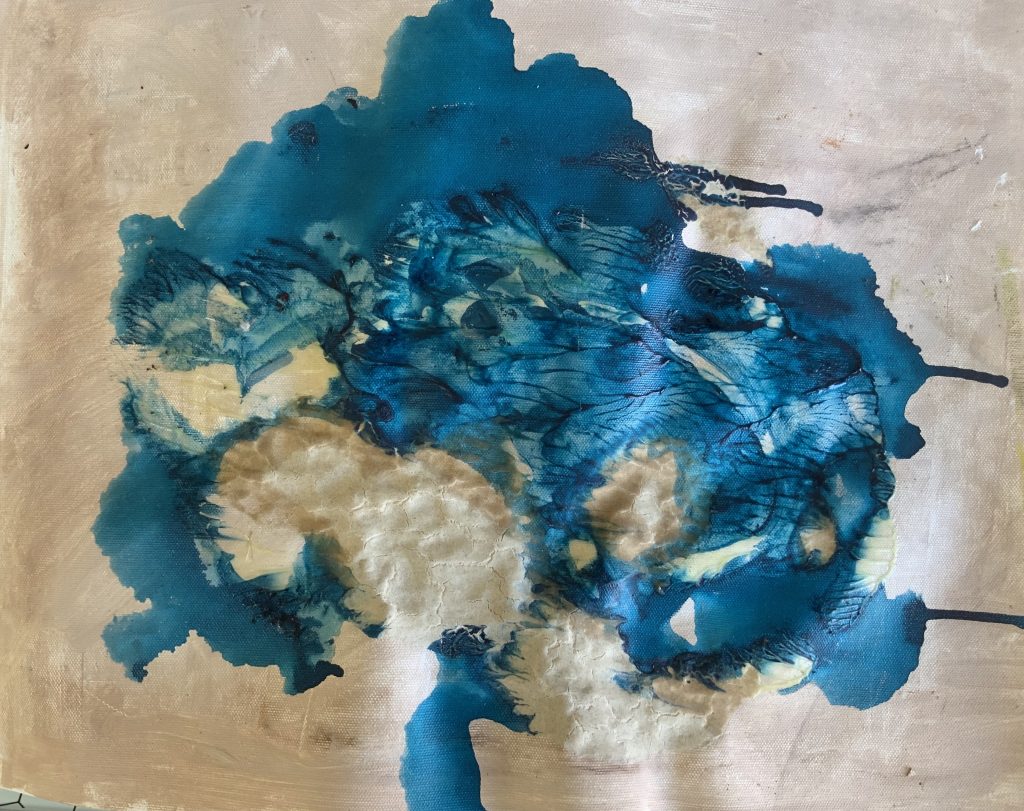
A quick google search leads me to a very interesting work by the artist, Laura Wilson. I found she does performances with dough: Fold and Stretch (2016), Rolling (2017), and You Would Almost Expect to Find it Warm (2018). (On the Intimacy of Bread and Performance, This is mold.com 26/10/21) These works stem from her interest in bread dough as a living material, which she describes as: “constantly responding to body heat, the air around it, it is absorbing the yeast from our skin, from its environment, but also the heat of the day or from who handles it [during performances]. So it can take on, in a way, a bit of a personality. Even your own mood can influence the dough,” she said. I get what she says – learned this from Griet. I like to think of this as embodied knowledge.
In order for me to bring the research about the Fungi Kingdom into my practice I used the following reading list and worked through these books whilst working on the project:
- 5Vibrant Matter, Jane Bennet
- The Mushroom at the end of the world on the possibility of life in capitalist ruin, Anna Tsing
- Entangled Life, Merlin Sheldrake
- The Hidden Life of Trees, Peter Wohllebe
- A Field Guide for Mushrooms of South Africa, H Levin, M Branch, S Rappoport, D Mitchell
Below is a screenshot of a drawing taken from the online book, Entangled Life (Sheldrake, 2020: 58), which describes different mycelial types and which inspired me to make the paintings illustrated as Fig. 7, 17 and 18.
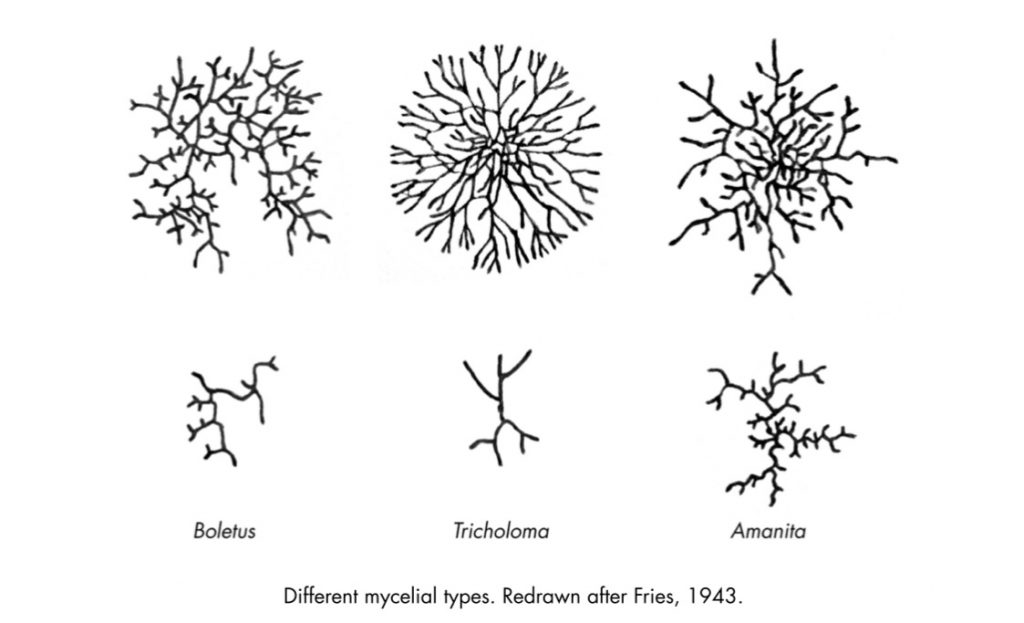
This project will include referring to collaboration and an envisioned online exhibition with the OCA EU student group. A fellow OCA, Textiles student in the Europe Group, Annette Holtkamp, who has made fungi with homemade materials was sharing her work with me after we had discussions about our shared interest in the Fungal Kingdom. Below are two images showing her work. These objects were made of compostable and eco-friendly materials, like yeast, pastry dough, silk noil, dyes from hazelnut ink, and paper mache. These materials become another metaphor for fungi being a natural composter in this world.
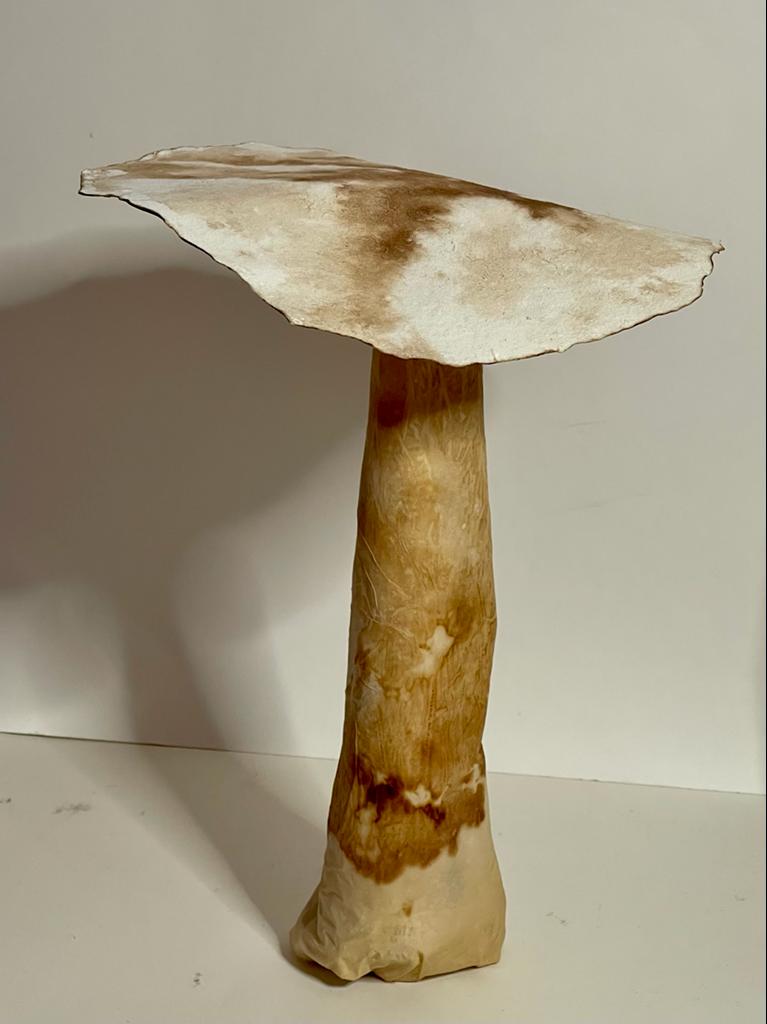
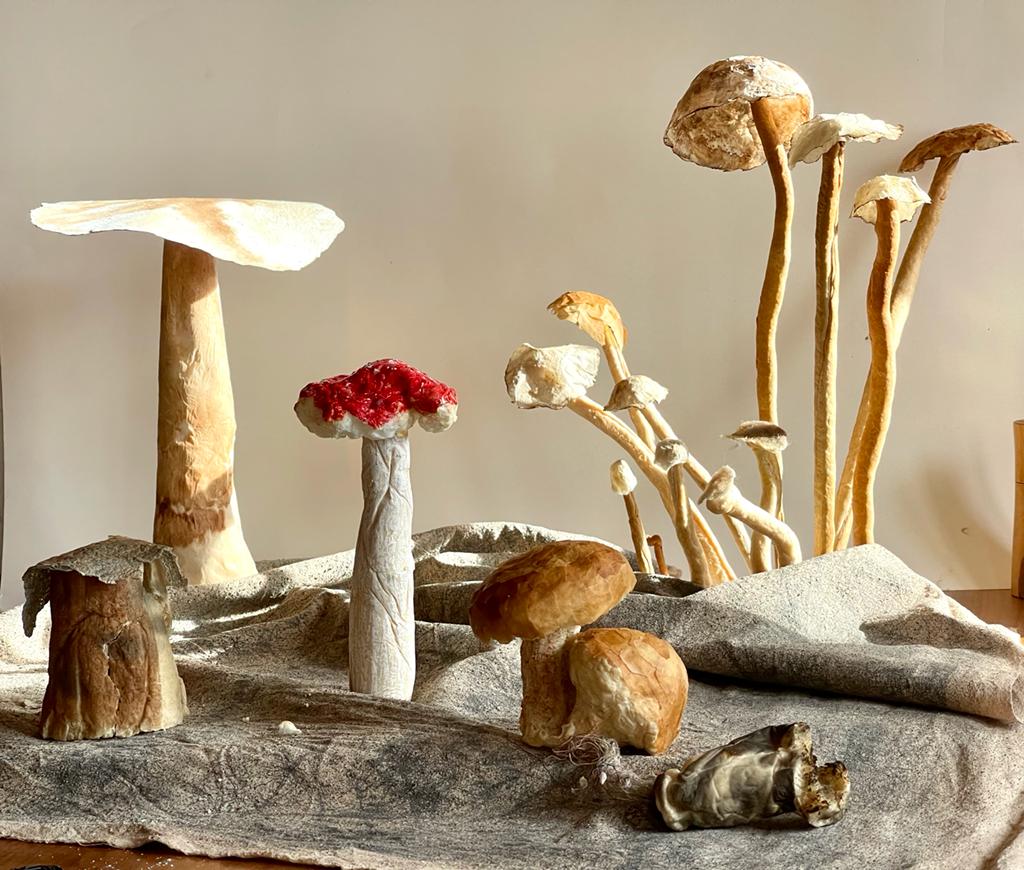
I am part of a 3 member group whose task is to plan to organise an online exhibition and to organise student and tutor workshops in the build-up to this event, which is planned for June/July 2022. In late July 2021, we (this 3 member group) put together ideas of what we wanted to achieve by doing these sessions as there was a need in the EU student group for training on the use of social media platforms and the use of a virtual exhibition. We envisioned a minimum of three practical workshops and contacted tutor Diana Ali as an art mentor. We host and plan these events, communicate with the group and tutor, set up other social media platforms, such as a private Facebook group, and Padlet, as well as use GoogleDrive to share information and help the creative practice which is virtual. Workshops were planned for early November 2021, early January 2022, and April 2022. A title to start off and invite students was: Cross the borders, make art, and share it online. We hoped for a minimum of 10 participants and started the first workshop with 22 interested group members. At the first group meeting and workshop, a name for the project was assigned: Wonder/wander Wide Web, and I felt comfortable with my project around fungi as well as working with other students with similar interests. The aims of the project were seen as:
To learn more about each other and encourage co-operation between students
To expand our creative practice by exchanging ideas
To learn to curate a virtual show (artists statement, using social media platforms, curation, marketing the show.
In a conversation with students of this OCA EU collaboration group, it was decided to have a few reading sessions, our book of choice became Entangled Life by Sheldrake. Our first discussion was on Chapter 3 of the book, Entangled Life (Sheldrake, 2021: 51 -75). We considered how mycelium can be applied in our own practice – learning from networking and relationships. Interesting was that mycelium is about the HOW of fungi feeding, and how it differs from ‘us animals’: we put food in our bodies, and fungi put their bodies in the food. These mycelium networks differ from thick to thin (hyphae: the branched mycelium) as well as the length of these networks. Hypae grows by getting longer, and mostly from their tips. Already I think my reader understands how this project is becoming entangled with reading, discussions, images, mushrooms, making and so much learning. I also learned in this chapter that mushrooms, like mycelium, are made of hyphae. What I take from this reading is also that mycelial networks work like other network-based organisms (computers) there are ‘decision gates’ and processing units – this research is still in its infancy and there are many questions that still need to be answered. It is now undeniable that these shared mycorrhizal networks are widespread in nature and that they have an important ecological role. The idea that struck me is that these collaborations between fungi and plants in nature indicate competition and cooperation. Sheldrake takes about an ‘alloy of competition and cooperation. (Sheldrake, 2021: 166).
I walk away with a quote from Charles Darwin in this paragraph: “Intelligence is based on how efficient a species becomes at doing the things they need to survive” (Sheldrake, 2021: 71) When I compare this with Jane Bennet’s description of when Darwin looked at earthworms ( Bennet, 2010: 96) I realise how the mycelium when at work, becomes a supportive environment that is being created underground.
ABOUT COLLABORATIONS, ENTANGLEMENTS, ASSEMBLAGE, SYMBIOSES, MUTUALISM, and CONTEXTUALIZING IDEAS
Tsing defines collaboration as working across difference. It becomes clear that we as human beings are dependent on livable collaborations, which also include contamination and adaptation to damaged environments. (p29)
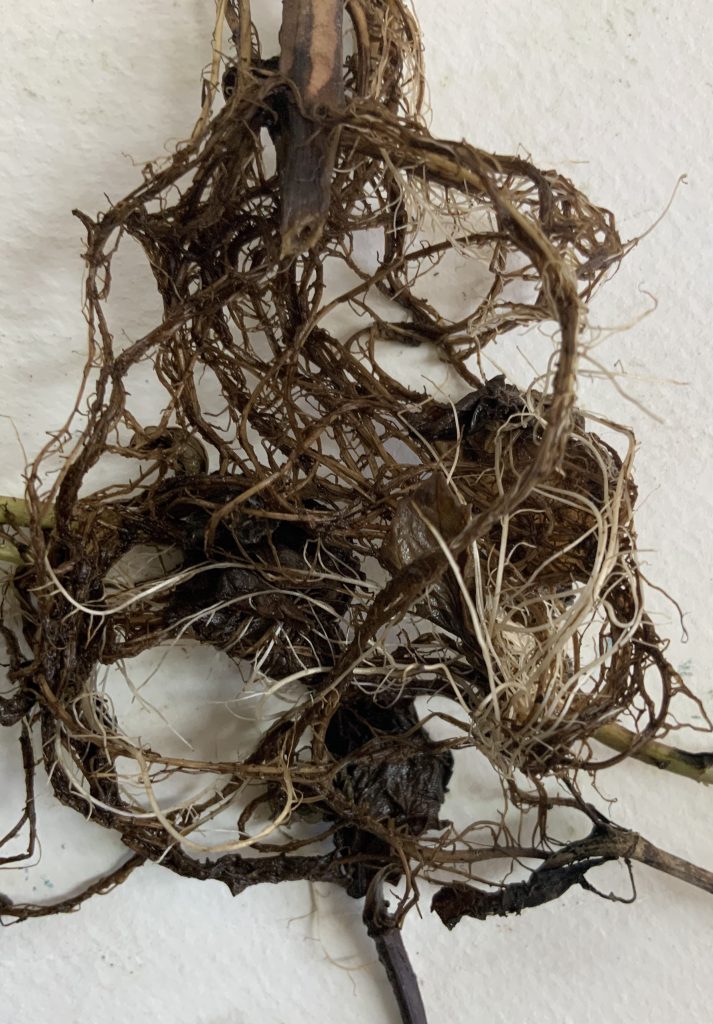
This project is about a non-human subject and there is new learning in attempting to understand how symbiosis can inform collaboration, and participation in art practices. I believe that I could also use this experience to learn about balance and reciprocity within the art world – thinking about the types of relationships that can be created between me and fellow students, or even a wider community. I am not sure how these experiences will develop, but I would like to think of them as socially engaging. I consider that Barad sees agency as an enactment, “Agency is a matter of intra-acting; it is an enactment, not something that someone or something has. Agency cannot be designated as an attribute of ‘subjects’ or ‘objects'” (Barad 1998, 112).
The world of Fungi is about a living world below the forest floor, a world I did not know very much about, but which interests me increasingly. In her work around the Matsutake mushrooms, Anna Lowenhaupt Tsing talks about fungal bodies that ‘extend themselves in nets and skeins, binding roots and mineral soils, long before producing mushrooms. All books emerge from similarly hidden collaborations.”(Tsing, 2015: 14) I find this such a powerful idea at the beginning of this project, which will obviously include a lot of reading about mushrooms, experimenting with materials, making, and collaborating with other students/artists. It reminds me of how Bennet defines assemblages, namely as ‘ad-hoc groupings of diverse elements of vibrant materials of all sorts” (Bennet, 2010:23) and that we as humans should try and find a ‘more horizontal representation of the relation between human and nonhuman actants’ if we want to be more faithful to each style of action within these relationships(assemblages). (Bennet, 2010:98).
I will be considering my Fungi Collaboration with students within the OCA EU student group, and with a local couple who live close by and do mushroom foraging and will take me along, as soon as the weather permits. This created new opportunities for having real mushrooms as material to explore, make spore prints and learn more about mycology. Bennet describes the elements of an assemblage as that each element “maintains an energetic pulse slightly “off” from that of the assemblage” (Bennet 2010:24) My understanding is that the assemblage is not about getting a full alignment, it merely becomes something else, as the elements become something else than themselves. This sits very well with ideas around drawing – thinking as you draw and this is the process of how you develop form, which can be seen as the shape of your thoughts. In my research in course work I viewed a conversation with artist, Amy Sillman, at Alex Katz Chair in Painting, 2020, where she also discuss these as principles around her own making.
The metaphors for working with fungi will develop – hidden collaborations sounds good! I become aware that fig can be a barometer for the ecosystem’s health, an (underground) network, food or delicacy, and even new specimens to identify, and in my case new learning.
“Worms have played a more important part in the history of the world than most persons would at first assume” (Mould, 305) as quoted from Vibrant Matter, p 96
The amazing thing about mycelial fungi networks is that they are flexible and can remodel themselves. It still stays a mystery why mycelial fungi work as networks and how they sense their environment and send signals through this network. I can only agree with Sheldrake that this is like standing in front “at the entrance to one of the oldest of life’s labyrinths”. (Sheldrake, 2021:75)
CONSIDERING HOW THE OCA COULD SUPPORT THE COLLABORATION EFFORT OF THE EU OCA STUDENT GROUP
On the OCA website, I found the following information through one of my fellow group members, Sonia. I think this option should be investigated in this project as a case study.
OCA Enterprise aims to develop post-study skills, provide opportunities to network with other students, alumni, and businesses, and help launch student initiatives.
The Enterprise Scheme is open to all students at Level Two (HE5), and Level Three (HE6). This is to cover activities that support you in securing your ambition post-study.
This could be attending a conference, an exhibition, a training course or an event. It could be setting up a project with other students to design graphics for e-greetings cards, or investing in digital technology to enable you to take innovative images.
Applications are open to individuals or groups of students. The amount of funding available is £100 per individual, or £150 per individual when applying as part of a group. We encourage students to collaborate in projects and apply as part of a group.
At the end of your project or activity, you’ll be asked to write up a case study so we can see what impact the funding has had, and use your experiences to encourage others to access this funding too.
I contacted OCA tutor Cheryl Huntbach on 5 September 2021 per email, to enquire if OCA owned any virtual exhibition space and possible access for our group. After an introduction email to Paul Vincent, Head of Technology and OCA, by Me Huntbach, I explained the project to P Vincent, and my follow-up email conversations with him focussed on our need to have a virtual platform, an estimated budget, and financial implications. On 31 March 2022, he confirmed that the cost of our choice of platform was fully paid and registered by OCA. He kindly shared the necessary login and passwords to use this platform with me in an email conversation. This became a major step in the process and the rest of the group is now all involved in creating the online exhibition. In the meantime, Sonia shared a short email on the student, OCASA site about our process and planned exhibition. (link: )
WORDLIST I will keep alongside my reading
Fungi: it is a taxonomical classification of fungi, which includes yeasts, moulds, and mushrooms
Mushroom: is the fruiting body of fungi
Spores: are the reproductive units dispersed by the mushroom bodies
Mycelium is the term to describe the vegetative part of fungi and it resides underground
Mycology is the study of fungi and professionals and amateurs do mycological practice when they study fungi in the field or in a lab context.
Mushroom hunting or foraging is seen as a way to collect (catalogue and log) or observe samples and or the conditions where species grow for identification and or to find edible ones to consume
Mycorrhiza are joint structures made from the interaction between tree roots and fungi (sugar transfers and soil nutrients are made available in this process) It originates from the Latin myco which is fungi, and rhiza, which is root). https://www.nps.gov/mora/learn/nature/mycorrhizal-fungi.htm
Mycorrhizal fungi – the circulatory system, of symbioses inside a plant/tree roots to get access to nutrients and water.
Saprobic – getting its nutrients from non-living organic material, such as decaying plant or animal matter.
Merlin Sheldrake referred to an art piece in Friedrichsplatz Park, in Kassel, Germany, called The Vertical Earth Kilometer. (2020,156) Looking at this work online, I immediately felt connected to the idea of the artist trusting the viewer to confirm its existence. This work is mostly underground, to be exact, one km solid brass rod was sunk into the earth, with only a very small, unassuming part showing, the 5.1 cm diameter of the pole.
List of Illustrations
Fig. 1 Stander, K. (2021) Detail of mushroom cap [bongo clay object] In possession of: the author: Langvlei Farm, Riebeeck West, South Africa.
Fig. 2 Stander, K. (2021) Bongo clay mushroom. [bongo clay object] In possession of: the author: Langvlei Farm, Riebeeck West, South Africa.
Fig. 3 Stander, K. (2021) Drawing on paper [ink, acrylic paint] In possession of: the author: Langvlei Farm, Riebeeck West, South Africa.
Fig. 4 Stander, K. (2021) Drawing on paper in Mixed medium [Ink, charcoal, chalk and acrylics] In possession of: the author: Langvlei Farm, Riebeeck West, South Africa.
Fig. 5 Stander, K. (2021) Work in progress, the underpainting [acrylic medium and ink] In possession of: the author: Langvlei Farm, Riebeeck West, South Africa.
Fig. 6 Stander, K. (2021) Close up look of WIP [acrylic medium and ink] In possession of: the author: Langvlei Farm, Riebeeck West, South Africa.
Fig. 7 Stander, K. (2021) Nets and Skeins: fungal mycelium as I imagine them to be [acrylic medium, ink on paper] In possession of: the author: Langvlei Farm, Riebeeck West, South Africa.
Fig. 8 Sheldrake, M. (2020) Mycelium illustration [photograph] In: Entangled Life: How fungi make our worlds, change our minds, and shape our futures. (2020) Dublin: Penguin Random House UK. p. 7.
Fig. 9 Stander, K. (2022) Image of foraged Shaggy Parasol [photograph] In possession of: the author: Langvlei Farm, Riebeeck West, South Africa.
Fig. 10 Stander, K. (2022) Image of a spore print of the Shaggy Parasol [photograph] In possession of: the author: Langvlei Farm, Riebeeck West, South Africa.
Fig. 11 Stander, K. (2022) Image of a spore print of the Shaggy Parasol [photograph] In possession of: the author: Langvlei Farm, Riebeeck West, South Africa.
Fig. 12 Stander, K. (2022) Image of disintegrated Shaggy Parasol [photograph] In possession of: the author: Langvlei Farm, Riebeeck West, South Africa.
Fig. 13 Stander, K. (2022) Close-up image of Shaggy Parasol [photograph] In possession of: the author: Langvlei Farm, Riebeeck West, South Africa.
Fig. 14 (2021) Found image of bark [photograph] in possession of: the author: Langvlei Farm, Riebeeck West, South Africa.
Fig. 15 Stander, K. (2021) Lichen on rocks [photograph] In possession of: the author: Langvlei Farm, Riebeeck West, South Africa.
Fig. 16 Instagram post by Rene Snyman with user comments (2022)[Instagram screenshot] At: https://instagram.com (Accessed 17/05/2022)
Fig. 17 Stander, K. (2021) Mycelium imagined [Mixed media, ink, acrylic medium, graphite pencil on canvas] In possession of: the author: Langvlei Farm, Riebeeck West, South Africa.
Fig. 18 Stander, K. (2021) Mycelium in Blue[Mixed media, ink, yeast, medium on canvas paper] In possession of: the author: Langvlei Farm, Riebeeck West, South Africa.
Fig. 19 Sheldrake, M. (2020) Different Mycelial Types. Redrawn after Fries (1943) [photograph] In: Entangled Life: How fungi make our worlds, change our minds, and shape our futures. (2020) Dublin: Penguin Random House UK. p. 58.
Fig. 20 Holtkamp, Annette. (2020) Fungi 3d object [photograph] In possession of Holtkamp, A: Bern, Switzerland.
Fig. 21 Holtkamp, Annette. (2020) Fungi made with eco fabric [photograph] In possession of Holtkamp, A: Bern Switzerland.
Fig. 22 Stander, K. (2020) Roots [photograph] In possession of: the author: Langvlei Farm, Riebeeck West, South Africa.
BIBLIOGRAPHY
Barrad, Karen, 1989. Meeting the Universe Halfway: Quantum Physics and the Entanglement of Matter and Meaning. Durham: Duke University Press, 2007
Bennet, Jane 2010. Vibrant Matter: a political ecology of things. Duke university press online 2010 as PDF At: OCA library (Accessed October 2021)
Deleuze, Giles, 1990. The logic of Sense. London: Bloomsbury Publishing Plc
Ingold, Tim, 2017. Correspondences: Knowing from the inside. [PDF] At: https://knowingfromtheinside.org/files/correspondences.pdf (Accessed online on 22 October 2021)
Klein, Joanna, 2019. When Fungi fight back [online article in New York Times] At: https://www.nytimes.com/2019/01/15/science/fungus-threat-detection.html?partner=IFTTT (Accessed online 16 February 2022)
Shelldrake, Merlin, 2020. Entangled Life: How fungi make our worlds, change our minds, and shape our futures. Dublin: Penguin Random House penguin.co.uk/vintage
Tsing, Anna Lowenhaupt 2015. The mushroom at the end of the world: on the possibility of life in capitalist ruins. Princeton University Press, Read online as PDF at : SCRIBD (Accessed on December 2021)
Wells, Liz, 2002. Land Matters: Landscape Photography, Culture and Identity. [ebook] At: https://ebookcentral.proquest.com/lig/ucreative-ebooks/detail.action?docID=830122 (Accessed on June 2022)